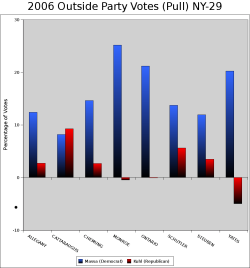Pull in the 2008 Election
Reader John sent me a painstakingly detailed spreadsheet of data from the 2006 election. In it, John studied registration and turnout in the 29th, town-by-town and county-by-county. One of the factors John studied was "pull", or the ability of a candidate to garner votes beyond their base.
In New York State, voters may leave their voter registration card blank. In the 29th, 20% of the registrants are "blanks", a little over 30% are Democrats, and a smidgen under 50% are Republicans. Since Eric Massa received 49% of the vote in 2006, it stands to reason that a fair number of blanks and/or Republicans pulled the lever for Massa. It's also reasonable to assume that most of the "pulls" for Massa came from blanks or independents..
To better understand the data in John's sheet, I've created a couple of graphs. The first details the turnout by county and party. As you can see, Republican and Democratic turnout is neck-and-neck in the 29th, but blanks tend to turn out in far smaller percentage than those who choose a party registration. (Note that John has combined Working Families, Green and Liberal in to the Democratic numbers, and Independence, Conservative and Right-to-Life into the Republican numbers.)
 The second graph shows pulls, by county. Massa generally out-pulled Kuhl by a wide margin. In the big northern counties, Monroe and Ontario, Massa displays huge pull. Kuhl out pulls Massa only in far southern Cattaraugus County.
The second graph shows pulls, by county. Massa generally out-pulled Kuhl by a wide margin. In the big northern counties, Monroe and Ontario, Massa displays huge pull. Kuhl out pulls Massa only in far southern Cattaraugus County.
Since 2008 is a Presidential election year, turnout in the 29th will probably be higher. In 2004, it was approximately 30% higher than 2006. It's probably safe to assume that the 2008 will see a similar increase. Using John's data as a basis for speculation, I can envision a couple of possibilities for the 60,000 additional voters who will come to the polls.
If the additional voters arrive in the same proportion of Democrats, Republicans and blanks as 2006, then Kuhl's probably facing another squeaker. But what if blanks tend to turn out in greater numbers during presidential years? This makes some sense: if you're not committed enough to declare a party, you may only be committed enough to go to the polls to vote for President. If this is true, and blanks turn out in higher proportions in 2008, then Kuhl is in trouble, because a reasonable inference from these numbers is that he has little pull outside his party.
Update 7/26: Reader John contacted me and noted that I had mis-interpreted one of the pages in his spreadsheet. I've removed the graph and stricken the paragraph that was the result of the misunderstanding. Sorry about that.
Comments
This is fascinating. Thanks for taking the time to compile it. Has that 'sore loser' impression from last November pretty much passed, based on your own anecdotal evidence? It sure didn't help Massa and I still regret it. When each and every vote counts, I think it's important to sustain the high road!
The Independence line shouldn't be lumped in as Republicans -- last year their line was Spitzer, Clinton, and Kuhl. Important distinction as the "Independence" party pulls in a lot of 'blanks' who thought they were signing up to be 'independents' on the registration card.
OG - I haven't seen any mention of it. I think in retrospect, people realize that waiting a few days for the votes to be counted does not make the candidate a sore loser.
Erik - Good point, but the data I have is already lumped together.